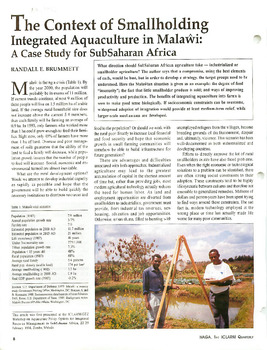Please use this identifier to cite or link to this item:
https://hdl.handle.net/20.500.12348/2800
The context of smallholding integrated aquaculture in Malawi: a case study of SubSaharan Africa
| dc.creator | Brummett, R.E. | |
| dc.date.accessioned | 2019-02-25T02:54:52Z | |
| dc.date.available | 2019-02-25T02:54:52Z | |
| dc.date.issued | 1995 | |
| dc.identifier | na_1456.pdf | |
| dc.identifier.citation | NAGA 18 (4): 8-10 | |
| dc.identifier.uri | https://hdl.handle.net/20.500.12348/2800 | |
| dc.description.abstract | What direction should SubSaharan African agriculture take — industrialized or smallholder agriculture? The author says that a compromise, using the best elements of each, would be best, but in order to develop a strategy, the target groups need to be understood. Here the IVIalasilan situation is given as an example: the degree of food "insecurity"; the fact that little smallholder produce is sold; and ways of improving productivity and production. The benefits of integrating aquaculture into farms is seen to make good sense biologically. If socioeconomic constraints can be overcome, widespread adoption of integration would provide at least medium-term relief, while larger-scale mechanisms are developed. | |
| dc.format | application/pdf | |
| dc.language | En | |
| dc.publisher | ICLARM | |
| dc.rights | CC BY 4.0 | |
| dc.source | NAGA | |
| dc.title | The context of smallholding integrated aquaculture in Malawi: a case study of SubSaharan Africa | |
| dc.type | Journal Article | |
| dcterms.bibliographicCitation | Brummett, R.E. (1995). The context of smallholding integrated aquaculture in Malawi: a case study of SubSaharan Africa. NAGA 18 (4): 8-10 | |
| cg.coverage.country | Malawi | |
| cg.identifier.worldfish | 1456 | |
| cg.subject.agrovoc | development | |
| cg.subject.worldfish | small-scale aquaculture | |
| cg.contributor.affiliation | ICLARM | |
| cg.identifier.status | Open access | |
| cg.description.theme | Sustainable aquaculture | |
| worldfish.location.area | Africa |
Files in this item
This item appears in the following Collection(s)
-
Sustainable aquaculture [2735]
